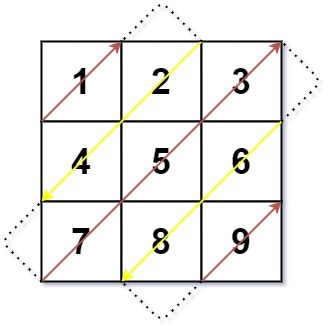Welcome to Subscribe On Youtube
498. Diagonal Traverse
Description
Given an m x n matrix mat, return an array of all the elements of the array in a diagonal order.
Example 1:

Input: mat = [[1,2,3],[4,5,6],[7,8,9]] Output: [1,2,4,7,5,3,6,8,9]
Example 2:
Input: mat = [[1,2],[3,4]] Output: [1,2,3,4]
Constraints:
m == mat.lengthn == mat[i].length1 <= m, n <= 1041 <= m * n <= 104-105 <= mat[i][j] <= 105
Solutions
-
class Solution { public int[] findDiagonalOrder(int[][] mat) { int m = mat.length, n = mat[0].length; int[] ans = new int[m * n]; int idx = 0; List<Integer> t = new ArrayList<>(); for (int k = 0; k < m + n - 1; ++k) { int i = k < n ? 0 : k - n + 1; int j = k < n ? k : n - 1; while (i < m && j >= 0) { t.add(mat[i][j]); ++i; --j; } if (k % 2 == 0) { Collections.reverse(t); } for (int v : t) { ans[idx++] = v; } t.clear(); } return ans; } } -
class Solution { public: vector<int> findDiagonalOrder(vector<vector<int>>& mat) { int m = mat.size(), n = mat[0].size(); vector<int> ans; vector<int> t; for (int k = 0; k < m + n - 1; ++k) { int i = k < n ? 0 : k - n + 1; int j = k < n ? k : n - 1; while (i < m && j >= 0) t.push_back(mat[i++][j--]); if (k % 2 == 0) reverse(t.begin(), t.end()); for (int& v : t) ans.push_back(v); t.clear(); } return ans; } }; -
class Solution: def findDiagonalOrder(self, mat: List[List[int]]) -> List[int]: m, n = len(mat), len(mat[0]) ans = [] for k in range(m + n - 1): t = [] i = 0 if k < n else k - n + 1 j = k if k < n else n - 1 while i < m and j >= 0: t.append(mat[i][j]) i += 1 j -= 1 if k % 2 == 0: t = t[::-1] ans.extend(t) return ans -
func findDiagonalOrder(mat [][]int) []int { m, n := len(mat), len(mat[0]) var ans []int for k := 0; k < m+n-1; k++ { var t []int i, j := k-n+1, n-1 if k < n { i, j = 0, k } for i < m && j >= 0 { t = append(t, mat[i][j]) i++ j-- } if k%2 == 0 { p, q := 0, len(t)-1 for p < q { t[p], t[q] = t[q], t[p] p++ q-- } } for _, v := range t { ans = append(ans, v) } } return ans } -
function findDiagonalOrder(mat: number[][]): number[] { const res = []; const m = mat.length; const n = mat[0].length; let i = 0; let j = 0; let mark = true; while (res.length !== n * m) { if (mark) { while (i >= 0 && j < n) { res.push(mat[i][j]); i--; j++; } if (j === n) { j--; i++; } i++; } else { while (i < m && j >= 0) { res.push(mat[i][j]); i++; j--; } if (i === m) { i--; j++; } j++; } mark = !mark; } return res; } -
impl Solution { pub fn find_diagonal_order(mat: Vec<Vec<i32>>) -> Vec<i32> { let (m, n) = (mat.len(), mat[0].len()); let (mut i, mut j) = (0, 0); (0..m * n) .map(|_| { let res = mat[i][j]; if (i + j) % 2 == 0 { if j == n - 1 { i += 1; } else if i == 0 { j += 1; } else { i -= 1; j += 1; } } else { if i == m - 1 { j += 1; } else if j == 0 { i += 1; } else { i += 1; j -= 1; } } res }) .collect() } }